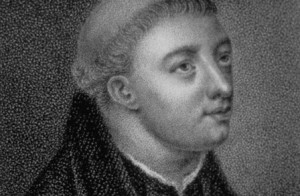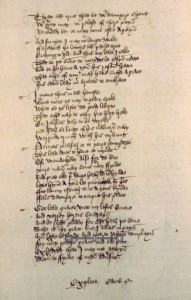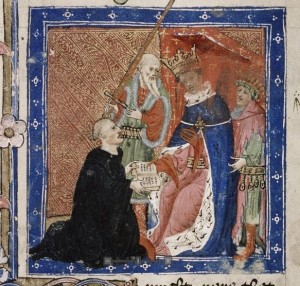Yes, I’m still here plowing along at Lydgate’s “A Complaynt of a Loveres Lyfe,” and here is where I left off last time. Let’s resume getting to know the mystery knight…
Wherof astonied, my fote I gan withdrawe,
Gretly wondring what hit myght be
That he so lay and had no felowe,
Ne that I coude no wyght with him se,
Wherof I had routhe and eke pité;
I gan anon, so softly as I coude,
Amonge the busshes me prively to shroude;
We return to the image of the poet as voyeur who divulges his findings to the general populace. The narrator is perplexed by the knight’s state of being, and by the fact that he appears to be travelling alone. Those familiar with romance will immediately assume some form of quest, personal or otherwise. However, here no more is said except that the narrator will use his concealment to the advantage of his story. Interestingly, according to the OED, this is the first recorded version of the verb “shroude” in this sense, and Lydgate goes to use it in similarly innovative ways in later works, such as the first instance of “shroud” as a means of taking shelter in Life of Our Lady.
If that I myght in eny wise espye
What was the cause of his dedely woo,
Or why that he so pitously gan crie
On hys fortune and on his eure also,
With al my myght I leyde an ere to
Every worde to marke what he sayed
Out of his swogh among as he abreyde.
This is a pretty straightforward stanza in which the narrator situates himself as the curious party in hopes of deciphering the ailment of the injured knight who has recently swooned. Further, as he awaits the knight’s recovery he professes to make note of what he observes, intoning his role as recorder, with an implication towards his impartiality. In short, he is interested in the knight, but uninterested enough to simply observe and record.
But first, yf I shal make mensyon
Of hys persone and pleynly him discrive,
He was in sothe, without excepcion,
To speke of manhod, oon the best on lyve –
Ther may no man agein trouthe stryve –
For of hys tyme, and of his age also,
He proved was ther men shuld have ado.
Yet, before delving into the knight’s reasons for his injury and woeful demeanor, the narrator pauses to detail his person and countenance, which both appear well above average – even rendering him perhaps the best specimen of man to have ever lived. However, it must be noted that at this point these determinations prove to be premature, and either reliant upon hindsight where the narrator infuses the poem with characteristics learned later, or the narrator is making impartial value judgments that would necessarily negate his earlier stance towards objective observation from his shrouded spot. Regardless of which perspective the reader wishes to support, the narrator’s reputation becomes murky.
For oon the best ther of brede and lengthe,
So wel ymade by good proporsion
Yf he had be in his delyver strengthe;
But thoght and sekenesse wer occasion
That he thus lay in lamentacion,
Gruffe on the grounde in place desolate,
Sole by himself, awaped and amate.
The knight, here described as a highly attractive man is marred by his lovesickness. This is a recurring theme throughout such poetry as can be recalled from the knight in the Duchess and, perhaps more notably, Troilus. And further borrowing from Chaucer, with a hint towards the wondrous, Lydgate echoes the monk from the Prioresses’s Tale who “gruf he fil al plat upon the grounde” (line 1865). Then the last line will be used in proximity in the House of Glas where “that they with derknes were waped and amate” (line 401). Considering the kinds of love that will be at the forefront of both poems, their shared words can often be used to draw further parallels.
And for me semeth that hit ys syttyng
His wordes al to put in remembraunce,
To me that herde al his compleynyng
And al the grounde of his woful chaunce,
Yf therwithal I may yow do plesaunce,
I wol to yow, so as I can, anone
Lych as he seyde reherse everychone.
The narrator continues to affirm his decision to spy on the knight, stating that he believes it to be the most fitting option, and thus will attempt to record every word spoken as faithfully as possible.
But who shal helpe me now to compleyn?
Or who shal now my stile guy or lede?
O Nyobe! Let now thi teres reyn
Into my penne and eke helpe in this nede,
Thou woful mirre that felist my hert blede
Of pitouse wo, and my honde eke quake,
When that I write for this mannys sake.
It has been suggested the first two lines of this stanza are derived from the Monk’s Tale, lines 3853-3854, but the most interesting aspects are the rhetorical strategies employed. Lydgate begins with invocatio, imploring a being larger than himself for guidance and inspiration. However, as his invocation is underway he also makes use of aporia in which he feigns ignorance as to whom he will address his invocation, before proceeding with it and directing his apostrophe to Nyobe.
Lydgate relies on the image of Nyobe weeping to forge a connection between her and the lamenting knight. In the original story, Nyobe boasts to Leto about her fourteen children. Leto, having only given birth to two, Apollo and Artemis, commissions them to destroy Nyobe’s chilren. Apollo, with his bow and arrows, slays all seven of Nyobe’s sons, and Artemis uses her bow and arrows to slay all seven of her daughters. Nyobe escapes Leto’s wrath, but turns to stone. Despite being petrified, she never ceases her weeping, and that precise image of a weeping woman is here given to us by Lydgate.
While Nyobe’s love was not a romantic one like we shall find with the knight, both of these figures were nevertheless greatly consumed by the loss of loved ones, so it seems appropriate that Lydgate would chose Nyobe as his muse.
The last two lines of the stanza parallel similar lines in Troilus: “For which myn herte right now gynneth blede, / And now my penne, allas, with which I write, / Quaketh for drede of that I moste endite” (lines 4.12-14). The same sentiment can be found in different words earlier in the story, in Book II, as Criseyde writes her first letter to Troilus, shaking and panicking all the while, protesting to Pandarus that she “never dide thing with more peyne / Than writen this to which ye me constreyne” (lines 2.1231-1232). It appears the act of writing emotional matters (one’s own or another’s) is physically painful, and in a sense enacts the initial pain that prompted the act of writing.
For unto wo acordeth compleynyng,
And delful chere unto hevynesse;
To sorow also, sighing and wepyng
And pitouse morenyng unto drerynesse;
And who that shal write of distresse
In partye nedeth to know felyngly
Cause and rote of al such malady.
The narrator continues in the same vein, preferring to display the emotions he describes as vividly if he felt them himself. In fact, to best convey to the audience the reality of the situation, he will suffer the emotions himself. His ultimate goal is to present to us the condition of his characters as true in nature as possible.
With this, in my next segment of the poem we will see if Lydgate is up to the task, and how he sets out to achieve it.
Sources:
Krausser, E. “The Complaint of the Black Knight.”
Leach, Elizabeth Eva. Sung Birds: Music, Nature, and Poetry in the Later Middle Ages.
MacCracken, Henry Noble, ed. The Complaint of the Black Knight. In The Minor Poems of John Lydgate.
Norton-Smith, John, ed. A Complaynt of a Loveres Lyfe. In John Lydgate, Poems.
Spearing, A. C. The Medieval Poet as Voyeur.


